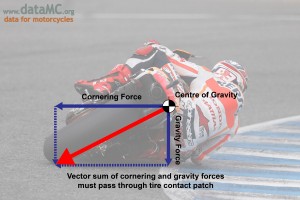So let me get this straight before it becomes a mess:
..increased downward force from pedalling..
When you pedal the downward force is not increased - you are not getting any heavier. You can only increase the downward force on a rear wheel by shifting your body back - this will decrease the downward force on front wheel though, which is good for steering actually. Controlling your body position is easier and more precise when not pedalling.
Cars actually act differently while cornering than bikes - bikes lean into the corner. But for the tires and traction that part is the same and you are right.

Maximum cornering angle is proportional to the coefficient of friction of the tires to the gravel/road/whatever (this is only affected by the tire tread and tire compound). The faster you want to go in corner the more you need to lean-in with you center of gravity. So if you manage to throw your body off seat closer to the ground the tires won't have to lean that much - see the picture - giving you a better cornering grip.
So the correct way is: Pedal before the corner to get your speed, then off the seat and control the centre of gravity for maximum cornering grip (you are not able to pedal now), keep weight on both wheels equally for steering, focus on hitting the corner apex (this is actually the most important part), then pedal again off the corner.
With bikes and cornering also the width of the rim plays a role. If running lower pressure to get more grip (bigger contact surface for the treads to bite into ground) with narrower rims you can get a tire blowout (when tubeless) or lose balance as the tire sidewalls have less support. Wider rims provide better support for cornering (but wider are also heavier giving less acceleration of wheel in straight line).
TL:DR: your logic is correct, pedalling is BS, use your body weight to your advantage, lower pressure, wider rims.TL:DR: your logic is correct, tire tread veeery important, pedaling is BS, use your body weight to your advantage, lower pressure, wider rims.
